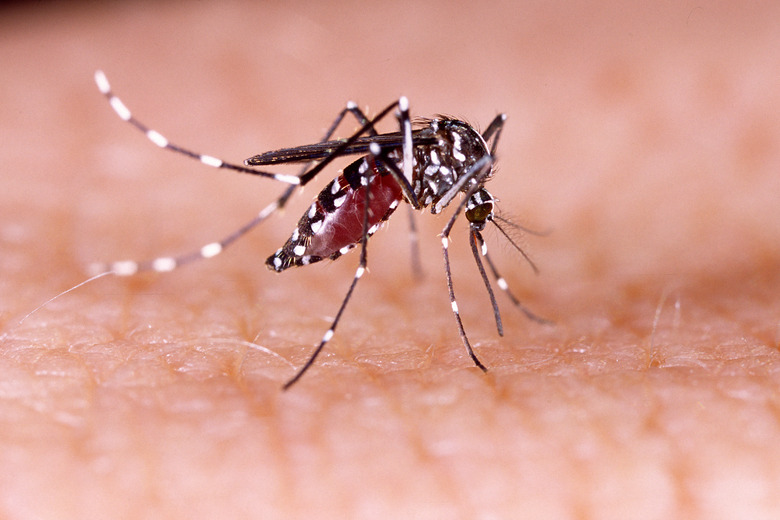Blood Sucking Insects & Bugs
From nectar-drinking bees to carnivorous mantids, insects have a diverse assortment of mouth designs particularly suited to their preferred diet. Bloodsucking insects can pierce the skin of their prey, inject an anticoagulant or blood thinner, and suck up the protein-rich blood, all with different parts of their mouths. While the most common bloodsucking insects are flies (Diptera), other groups of insects, such as true bugs (Hemiptera) and even some moths (Lepidoptera) have blood-feeding behaviors.
Mosquitoes
Mosquitoes
Of all the blood-feeding insects, mosquitoes are perhaps the most familiar. These flies belong to the widely distributed Culicidae family and can be found throughout the world, except for Antarctica. Only female mosquitoes drink blood; they require the protein to produce eggs. Immature mosquitoes, called larvae, live in standing water such as pools, ponds or gutters and feed on organic material in the water. Mosquitoes are attracted to the heat, carbon dioxide and lactic acid that animals produce. When a female mosquito lands on her prey, she injects a long tube, called a proboscis, into the skin. While she is sucking up blood, she releases saliva to prevent the blood from clotting. Human bodies have an allergic reaction to this saliva, which causes the skin to form itchy, red bumps after a mosquito bite. It is also this saliva that transmits diseases such as dengue fever, Zika virus, West Nile virus and malaria.
Black Flies
Black Flies
Similar to their mosquito cousins, it is only the female black fly (Simuliidae) that feeds on blood. Her razor-sharp mandibles cut the skin of mammals or birds so she can suck up a blood meal. Also like mosquitoes, black fly larvae are aquatic, but they prefer the flowing water of streams. Black flies are often called buffalo gnats due to their humpback shape. Despite their tiny size (about 5 millimeters in length), in large groups, these flies become a severe nuisance to livestock and wildlife.
Other Flies
Other Flies
Horse flies and deer flies (Tabanidae) are some of the larger blood-sucking flies at 10 to 25 millimeters long. Deer flies, the smaller of the two, are dark brown or black and have dark coloring on their wings. Females of these flies feed on blood, while males prefer nectar. As their name suggests, horse flies are often serious pests of livestock, but both of these creatures will bite humans, leaving painful cuts and swelling.
Lice
Lice
While there are many species of bloodsucking lice, only one group, the Pediculidae, feed on humans. Body lice, head lice and crab lice are tiny, flat-bodied, wingless insects. Head lice and body lice have a similar elongated shape, while crab lice resemble the crustacean. Head lice can be transmitted by sharing combs, brushes or hats and by direct contact. Female head lice attach their eggs to hair while female body lice leave their eggs in clothing. Once the eggs hatch, lice remain on their host for their lifetime, where they feed on blood. Head lice stay on the human head while crab lice typically prefer the pubic area. Both of these pests are annoying but not threatening. The body louse, however, is capable of transmitting diseases, particularly typhus, a highly infectious bacterial disease.
Bedbugs
Bedbugs
The flat, oval, reddish-brown bedbug (Cimicidae) hides in mattress seams, electrical outlets, or cracks in floors and walls and comes out for a blood meal at night. They can bite several times during the night until their bodies become engorged with blood, but they can survive for months without feeding. These pests leave red, itchy sores on the body. Bedbugs are difficult to remove from your home, and you may need to dispose of infested furnishings and carpets to remove them.
Fleas
Fleas
We usually think of fleas (Siphonaptera) as a problem for cats or dogs, but these bloodsucking pests are not always specific in their preferred hosts. Unlike lice or bedbugs, fleas can jump to different areas around the host as well as from one host to another. They can move from animals to humans indiscriminately. Some flea species are vectors for disease, particularly bubonic plague, which is transmitted by the rat flea.
Other Bloodsuckers
Other Bloodsuckers
Some noninsect creatures have bloodsucking behaviors. Parasitic forms of mites and ticks (Acarina), such as mange mites, chiggers and deer ticks are serious pests to animals and humans alike. Lyme disease is transmitted by a bloodsucking tick that burrows under the skin. A burrowing mite causes mange, a mammal skin disease that results in scabs, hair loss and severe itching.
References
- Journal of Insect Science: Proboscis Morphology and Its Relationship to Feeding Habits in Noctuid Moths
- Centers for Disease Control and Prevention: Hematophagous Endeavors, Fact and Fancy
- Purdue University: Black Flies
- University of Florida Entomology and Nematology: Black Flies
- University of Kentucky Entomology: Horse Flies and Deer Flies
- National Pesticide Information Center: Bedbug Biology and Behavior
Cite This Article
MLA
Godawa, Jean. "Blood Sucking Insects & Bugs" sciencing.com, https://www.sciencing.com/blood-sucking-insects-bugs-6210256/. 11 April 2018.
APA
Godawa, Jean. (2018, April 11). Blood Sucking Insects & Bugs. sciencing.com. Retrieved from https://www.sciencing.com/blood-sucking-insects-bugs-6210256/
Chicago
Godawa, Jean. Blood Sucking Insects & Bugs last modified August 30, 2022. https://www.sciencing.com/blood-sucking-insects-bugs-6210256/
